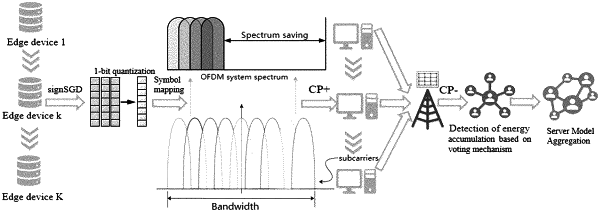| CPC H04W 52/0258 (2013.01) [H04W 52/0229 (2013.01)] | 9 Claims |

|
1. A dynamic power control method for resisting multi-user parameter biased aggregation in federated learning, comprising the following specific implementation steps:
(1) establishing a federated learning system model for resisting parameter biased aggregation;
(2) constructing a corresponding objective function based on a training purpose of the federated learning system model;
(3) introducing, according to the federated learning system model established in step (1), a power control factor for resisting user biased gradient aggregation, and determining a corresponding over-the-air computation communication model;
(4) processing the signal by the receivers using the non-coherent energy detection method without cooperation between the receivers and a transmitters; and
(5) determining, according to the method in step (4), a federated learning security mechanism method based on resistance against parameter biased aggregation, and completing an updating training process of the federated learning system model,
wherein in step (3), the dynamic power control factor Prk(n) for resisting biased gradient aggregation is introduced, and the over-the-air computation communication model is shown in (VI):
 in Formula (VI), tk,c(n) is the sign transmitted at the kth user, hk,c(n) is the channel coefficient between the edge server and the kth user, hk,c(n)□ CN(0,1), tkc(n) ∈□ is the transmitted sign from the kth user, nk,c(n) is an additive white gaussian noise (AWGN) with a zero mean and variance σn2, c ∈ {0,1, . . . , R−1}, and the transmitted signal power of the kth user at the server is set as the introduced dynamic power control factor Prk(n);
in the over-the-air computation communication model, the communication process comprises the following specific implementation steps:
at the transmitter, mapping i ∈ {1,2, . . . , q} to different symbols during pre-processing, q being the number of vector parameters, based on the value gk,i(n) in the nth communication cycle and transmitted symbols tk,c+(n) and tk,c−(n) at the kth user, ∀i being shown in Formula (VII) and Formula (VIII):
 wherein √Es=1 is a factor to normalize the OFDM symbol energy , and sk,i(n) is a randomized sign on a unit circle;
introducing the dynamic power control factor Prk(n) for resisting biased gradient aggregation, superimposed signs yc+(n) and yc−(n) of given i at the receiver by setting the power configuration of each user being shown in Formula (IX) and Formula (X):
 wherein in Formulas (IX) and (X), hk,c+(n) and hk,c−(n) are channel coefficients corresponding to two sub-carriers, and nk,c+(n) and nk,c−(n) are corresponding channel noises respectively;
the dynamic power control method is applied to a federated learning security mechanism system, the federated learning security mechanism system comprising K users, an edge server, S orthogonal frequency division multiplexing (OFDM) symbols, and R active sub-carriers;
each user is connected to a central server;
training data of all the users are set to be multi-label data from the same feature space, the total number of labels being L;
each local data point of any user has the same type of label, local data of a marked data sample on the kth user is represented by Dk, (xl, yl) ∈ Dk, xl and yl represent the data sample and the corresponding label, respectively, and the sum of the local data of all the users is D, satisfying: Σk=1κDk=D.
|